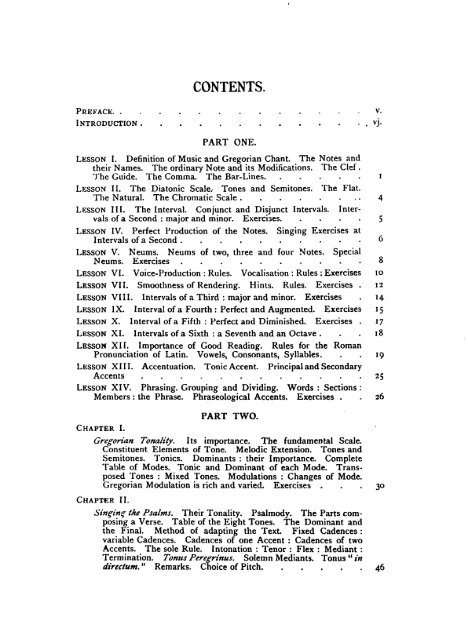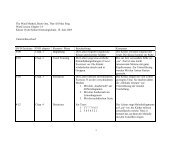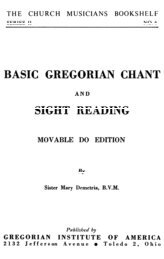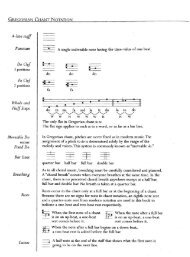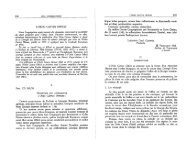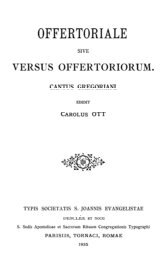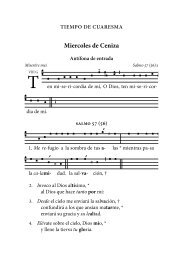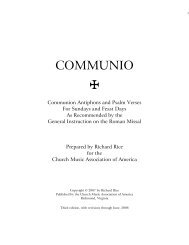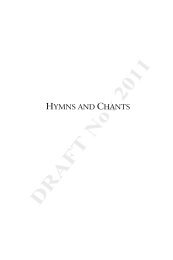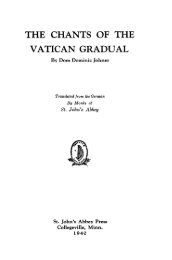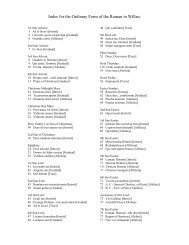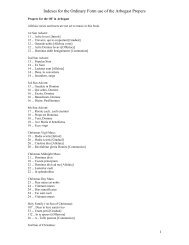Textbook of Gregorian Chant (1930) - MusicaSacra
Textbook of Gregorian Chant (1930) - MusicaSacra
Textbook of Gregorian Chant (1930) - MusicaSacra
You also want an ePaper? Increase the reach of your titles
YUMPU automatically turns print PDFs into web optimized ePapers that Google loves.
CONTENTS.<br />
PREFACE v.<br />
INTRODUCTION vj.<br />
PART ONE.<br />
LESSON I. Definition <strong>of</strong> Music and <strong>Gregorian</strong> <strong>Chant</strong>. The Notes and<br />
their Names. The ordinary Note and its Modifications. The Clef.<br />
The Guide. The Comma. The Bar-Lines i<br />
LESSON II. The Diatonic Scale. Tones and Semitones. The Flat.<br />
The Natural. The Chromatic Scale 4<br />
LESSON III. The Interval. Conjunct and Disjunct Intervals. Intervals<br />
<strong>of</strong> a Second : major and minor. Exercises 5<br />
LESSON IV. Perfect Production <strong>of</strong> the Notes. Singing Exercises at<br />
Intervals <strong>of</strong> a Second 6<br />
LESSON V. Neums. Neums <strong>of</strong> two, three and four Notes. Special<br />
Neums. Exercises 8<br />
LESSON VI. Voice-Production : Rules. Vocalisation : Rules : Exercises IO<br />
LESSON VII. Smoothness <strong>of</strong> Rendering. Hints. Rules. Exercises . 12<br />
LESSON VIII. Intervals <strong>of</strong> a Third : major and minor. Exercises . 14<br />
LESSON IX. Interval <strong>of</strong> a Fourth : Perfect and Augmented. Exercises 15<br />
LESSON X. Interval <strong>of</strong> a Fifth : Perfect and Diminished. Exercises . 17<br />
LESSON XL Intervals <strong>of</strong> a Sixth : a Seventh and an Octave . . .18<br />
LESSON XII. Importance <strong>of</strong> Good Reading. Rules for the Roman<br />
Pronunciation <strong>of</strong> Latin. Vowels, Consonants, Syllables. . . 19<br />
LESSON XIII. Accentuation. Tonic Accent. Principal and Secondary<br />
Accents 25<br />
LESSON XIV. Phrasing. Grouping and Dividing. Words : Sections:<br />
Members : the Phrase. Phraseological Accents. Exercises . . 26<br />
CHAPTER I.<br />
PART TWO.<br />
<strong>Gregorian</strong> Tonality. Its importance. The fundamental Scale.<br />
Constituent Elements <strong>of</strong> Tone. Melodic Extension. Tones and<br />
Semitones. Tonics. Dominants : their Importance. Complete<br />
Table <strong>of</strong> Modes. Tonic and Dominant <strong>of</strong> each Mode. Transposed<br />
Tones : Mixed Tones. Modulations : Changes <strong>of</strong> Mode.<br />
<strong>Gregorian</strong> Modulation is rich and varied. Exercises . . . 30<br />
CHAPTER II.<br />
Singing the Psalms. Their Tonality. Psalmody. The Parts composing<br />
a Verse. Table <strong>of</strong> the Eight Tones. The Dominant and<br />
the Final. Method <strong>of</strong> adapting the Text. Fixed Cadences :<br />
variable Cadences. Cadences <strong>of</strong> one Accent : Cadences <strong>of</strong> two<br />
Accents. The sole Rule. Intonation : Tenor : Flex : Mediant :<br />
Termination. Tonus Peregrinus. Solemn Mediants. Tonus *' in<br />
directum." Remarks. Choice <strong>of</strong> Pitch 46


